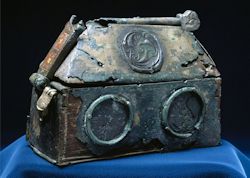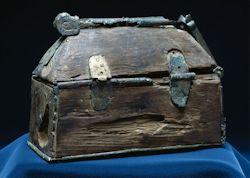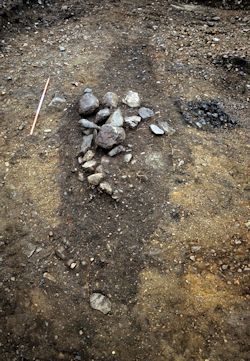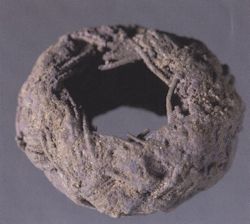
In addition to the groups described above, there are also five individual Insular finds of particular note: a complete reliquary shrine, a small silver button, a bronze bridle, an Anglo-Saxon disc-brooch, a jet bead and a part set of enamelled bronze mountings for a horse harness.

Although several of the bronze mounts found in Norway are thought to have originated as parts of reliquaries, only three complete shrines have ever been found in Norse burials in Norway (Heen-Pettersen 2013, 63). One of these shrines was found in a large grave-mound at Melhus, containing a boat burial where a man and a woman, usually believed to be husband and wife, had been laid to rest around AD 800. The reliquary is thought to have belonged to the woman. It is made of yew covered in bronze sheet, with a length of only 120mm and 80mm high. The lid is shaped like a roof with a high roof-tree and sloped gable-ends. On either side of the lid, there is a circular setting filled of tin plate, decorated with triskele ornaments (Figure 23 and Figure 24). The use and function of this shrine has been little discussed, although it has been suggested that it might have been the buried woman's personal 'keep-sake' box, to store small personal items such as jewellery, combs and the like (Heen-Pettersen 2013, 63). Reliquaries belonging to the same type as that from Melhus, characterised by having the shape of a small house with ridged roof and hipped ends, are known from Monymusk, Aberdeenshire, as well as Lough Erne and Shannon in Ireland, together with a fourth example currently preserved in the Copenhagen Museum.

A small circular openwork bronze disc, identified by Bakka (1963) as a possible late Anglo-Saxon disc-brooch, was recovered from a woman's grave at Fulset, Stjørdal, in 1873 (Figure 25). Traces of wear and refitting of the original pin show, however, that the brooch was of some age when put into the grave. The disc itself forms an equal-armed, Anglian cross with the arms splayed, so they touch one another and make the edge of the disc a closed circle. A close parallel to its form is provided by one of the Beeston Tor brooches (Bakka 1963, 23). The Fulset brooch was found together with two oval brooches of type P51, which generally date to the first half of the 10th century.

A small button (18mm in diameter) made of thin threads of silver, was recovered from a cremation placed in a 6m long, unburnt boat at Lø, Steinkjer, in 2001 (Figure 26, Figure 27). This burial was located close to the barrow where the previously discussed balance scale from Lø was discovered. The button is the only one of its kind found in Scandinavia, although several similar buttons have been found in Iceland, Ireland and the Isle of Man. Based on the design of the Lø button compared with known parallels, Grønnesby and Ellingsen (2012, 41) have suggested that this particular item may have been produced somewhere in the British Isles c. AD 920-960.

Only a small number of artefacts of jet or jet-like materials (e.g. lignite) are known from burials in Norway (Shetelig 1944; Resi 2005). In Trøndelag only one such object, a bead, is recorded. The bead has, however, not undergone further analysis to establish whether it is made from jet or another material. The bead formed part of a woman's necklace, found in a double burial covered by a large grave-mound at Klingen, Overhalla. The nearest source of jet is Whitby, North Yorkshire, and black lignite shales are also commonly found as glacial erratics in the boulder clays of northern and eastern England (Shepherd 1985, 204). Artefacts of jet or similar material from Viking-Age burials are therefore usually considered as Insular imports (e.g. Hunter 2008; Resi 2005).

Early types of bronze horse bridles are usually considered as Insular imports (e.g. Blindheim 1978; Petersen 1951, Jåtten 2006). One such bridle has been found in Trøndelag, at Nerrian, Skaun. Although found during ploughing, it probably came from a disturbed grave. Finally, Insular horse equipment is also represented by a set of enamelled bronze mountings from a man's cremation grave at Kolset, Steinkjer, dated to the 10th century. The set consists of three pieces of circular and square mounts, together with fragments of two twin-strap mountings. Although damaged by fire, several of the pieces bear remains of red enamel (Petersen 1940, 67-8). While a number of the reworked, bronze mounts found in Trøndelag are thought originally to have been part of horse harness, this is the only find where the mounts appear as part of a set.
Internet Archaeology is an open access journal based in the Department of Archaeology, University of York. Except where otherwise noted, content from this work may be used under the terms of the Creative Commons Attribution 3.0 (CC BY) Unported licence, which permits unrestricted use, distribution, and reproduction in any medium, provided that attribution to the author(s), the title of the work, the Internet Archaeology journal and the relevant URL/DOI are given.
Terms and Conditions | Legal Statements | Privacy Policy | Cookies Policy | Citing Internet Archaeology
Internet Archaeology content is preserved for the long term with the Archaeology Data Service. Help sustain and support open access publication by donating to our Open Access Archaeology Fund.
File last updated: Wed Dec 3 2014